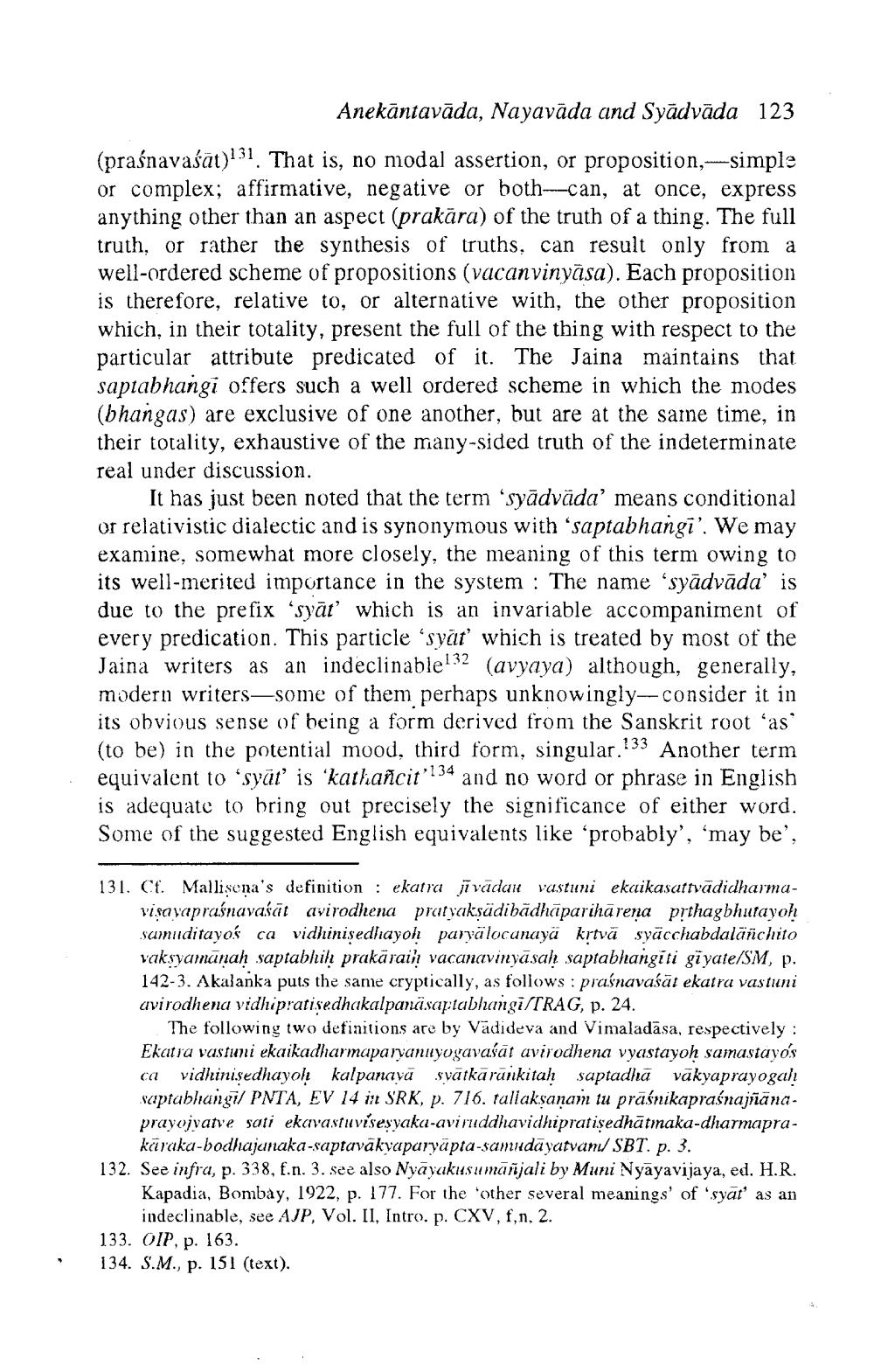________________
Anekāntavāda, Nayavāda and Syādvāda 123
(praśnavaśāt)131. That is, no modal assertion, or proposition ---simple or complex; affirmative, negative or both-can, at once, express anything other than an aspect (prakāra) of the truth of a thing. The full truth, or rather the synthesis of truths, can result only from a well-ordered scheme of propositions (vacanvinyāsa). Each proposition is therefore, relative to, or alternative with, the other proposition which, in their totality, present the full of the thing with respect to the particular attribute predicated of it. The Jaina maintains that saptabhangi offers such a well ordered scheme in which the modes (bhangas) are exclusive of one another, but are at the same time, in their totality, exhaustive of the many-sided truth of the indeterminate real under discussion.
It has just been noted that the term 'syādväda' means conditional or relativistic dialectic and is synonymous with 'saptabhangi'. We may examine, somewhat more closely, the meaning of this term owing to its well-merited importance in the system : The name 'syādvāda' is due to the prefix syāt which is an invariable accompaniment of every predication. This particle ‘syat' which is treated by most of the Jaina writers as an indeclinable 32 (avyaya) although, generally, modern writers—some of them perhaps unknowingly-consider it in its obvious sense of being a form derived from the Sanskrit root ‘as (to be) in the potential mood, third form, singular. Another term equivalent to 'syāt' is 'kathancit'134 and no word or phrase in English is adequate to bring out precisely the significance of either word. Some of the suggested English equivalents like 'probably', ‘may be',
131. Cf. Mallisena's definition : ekatra jīvadan vastuni ekaikasattvādidharma
vi.savapraśnavaśāt avirodhena pratyaksādibädhāpariharena prthagbhutayoh sumuditayoś ca vidhinisedhayoh parvälocanayā krtvā syācchabdalāñchito vaksyamanah saptabhih prakārain vacanavinyāsah saptabhangiti giyate/SM, p. 142-3. Akalanka puts the same cryptically, as follows : praśnavaśāt ekatra vastuni avirodhena vidhipratisedhakalpanāsaptabhangi/TRAG, p. 24.
The following two definitions are by Vadideva and Vimaladāsa, respectively : Ekatra vastuni ekaikadharmaparyanuyogavaśāt avirodhena vyastayoh samastayo's ca vidhinisedhayoh kalpanavā svātkārunkitah saptadhā vākyaprayogah saptabhangi/ PNTA, EV 14 in SRK, p. 716. tallaksanam tu praśnikapraśnajñana. prayojvatve sati ekavastuvíses yaka-aviruddhavidhipratisedhātmaka-dharmapra
käraka-bodhajunaka-saptavakvaparyāpta-samudayatvam/SBT. p. 3. 132. See infra, p. 338, f.n. 3. see also Nyayakusumajali by Muni Nyayavijaya, ed. H.R.
Kapadia, Bombay, 1922, p. 177. For the other several meanings' of 'syat as an
indeclinable, see AJP, Vol. II, Intro. p. CXV, f,n. 2. 133. OIP, p. 163. 134. S.M., p. 151 (text).




